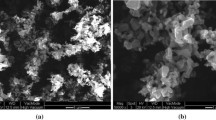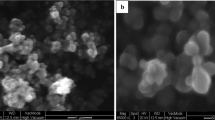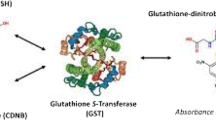Abstract
Metal oxide nanoparticles are widely used in industries, and peak level can be confirmed in their surroundings. In the present study, the sub-lethal effects of CuO-NPs from low to high concentration as 0.5 to 1.5 mg/L were observed in tilapia (Oreochromis mossambicus). Accumulation of copper from CuO-NPs was increased with the increase in doses, and maximum accumulation was found in the gill than liver and muscles. The increased lipid peroxidation level was observed in the gill as compared to liver, and the similar results were obtained in catalase and glutathione while superoxide dismutase level was higher in the liver than gills. In histological alterations, gill edema, curved tips, fusion of gill lamellae, and thickening of primary and secondary gill lamellae were observed. Necrosis and apoptosis with condensed nuclear bodies and pyknotic nuclei were observed in the liver at the highest dose concentration. In a genotoxic study, the highest value of % tail DNA and olive tail movement was observed with increasing concentrations. Copper oxide nanoparticles has greater potential to accumulate in the soft tissues, which may cause respiratory distress such as oxidative stress, induction of antioxidant defense by raising glutathione, organ pathology, and genotoxicity.




Similar content being viewed by others
Change history
14 February 2024
This article has been retracted. Please see the Retraction Notice for more detail: https://doi.org/10.1007/s11356-024-32453-4
References
Abdel-Khalek AA (2015) Risk assessment, bioaccumulation of metals and histopathological alterations in Nile tilapia (Oreochromis niloticus) facing degraded aquatic conditions. Bull Environ Contam Toxicol 94(1):77–83
Abdel-Khalek AA, Badran SR, Marie MAS (2016) Toxicity evaluation of copper oxide bulk and nanoparticles in Nile tilapia, Oreochromis niloticus, using hematological, bioaccumulation and histological biomarkers. Fish Physiol Biochem:1–12
Ahamed M, Siddiqui MA, Akhtar MJ, Ahmad I, Pant AB, Alhadlaq HA (2010) Genotoxic potential of copper oxide nanoparticles in human lung epithelial cells. Biochem Biophys Res Commun 396(2):578–583
Ahmad I, Oliveira M, Pacheco M, Santos MA (2005) Anguilla anguilla L. oxidative stress biomarkers responses to copper exposure with or without β-naphthoflavone pre-exposure. Chemosphere 61(2):267–275
Aitken R, Chaudhry MQ, Boxall ABA, Hull M (2006) Manufacture and use of nanomaterials: current status in the UK and global trends. Occup Med 56(5):300–306
Alarifi S, Ali D, Verma A, Alakhtani S, Ali BA (2013) Cytotoxicity and genotoxicity of copper oxide nanoparticles in human skin keratinocytes cells. Int J Toxicol 32(4):296–307
Al-Bairuty GA, Shaw BJ, Handy RD, Henry TB (2013) Histopathological effects of waterborne copper nanoparticles and copper sulphate on the organs of rainbow trout (Oncorhynchus mykiss). Aquat Toxicol 126:104–115
APHA (2005) Standard methods for the examination of water and waste water, 21st edn. American Public Health Association, Washington, DC
Bai W, Tian W, Zhang Z, He X, Ma Y, Liu N, Chai Z (2010) Effects of copper nanoparticles on the development of zebrafish embryos. J Nanosci Nanotechnol 10(12):8670–8676
Baker RTM, Handy RD, Davies SJ, Snook JC (1998) Chronic dietary exposure to copper affects growth, tissue lipid peroxidation, and metal composition of the grey mullet, Chelon labrosus. Mar Environ Res 45(4):357–365
Berntssen MH, Lundebye AK, Hamre K (2000) Tissue lipid peroxidative responses in Atlantic salmon (Salmo salar L.) parr fed high levels of dietary copper and cadmium. Fish Physiol Biochem 23(1):35–48
Bhatt I, Tripathi BN (2011) Interaction of engineered nanoparticles with various components of the environment and possible strategies for their risk assessment. Chemosphere 82(3):308–317
Buege JA, Aust SD (1978) Microsomal lipid peroxidation. Methods Enzymol 52:302–310
Buffet PE, Tankoua OF, Pan JF, Berhanu D, Herrenknecht C, Poirier L et al (2011) Behavioural and biochemical responses of two marine invertebrates Scrobicularia plana and Hediste diversicolor to copper oxide nanoparticles. Chemosphere 84(1):166–174
Carmona ER, Inostroza-Blancheteau C, Obando V, Rubio L, Marcos R (2015) Genotoxicity of copper oxide nanoparticles in Drosophila melanogaster. Mutat Res/Genet Toxicol Environ Mutagen 791:1–11
Chang H, Jwo CS, Lo CH, Tsung TT, Kao MJ, Lin HM (2005) Rheology of CuO nanoparticle suspension prepared by ASNSS. Rev Adv Mater Sci 10(2):128–132
Chaubey RC (2005) Computerized image analysis software for the comet assay. Mol Toxicol Protocol:97–106
Chen Z, Meng H, Xing G, Chen C, Zhao Y, Jia G et al (2006) Acute toxicological effects of copper nanoparticles in vivo. Toxicol Lett 163(2):109–120
Chupani L, Zusková E, Niksirat H, Panáček A, Lünsmann V, Haange S, Bergen M, Jehmlich N (2017) Effects of chronic dietary exposure of zinc oxide nanoparticles on the serum protein profile of juvenile common carp (Cyprinus carpio L.) Sci Total Environ 579:1504–1511
Chupani L, Niksirat H, Panáček A, Lünsmann V, Haange S, Bergen M, Jehmlich N, Zusková E (2018a) Insight into the modulation of intestinal proteome of juvenile common carp (Cyprinus carpio L.) after dietary exposure to ZnO nanoparticles. Sci Total Environ 613:62–71
Chupani L, Niksirat H, Velíšek J, Stará A, Hradilová V, Kolařík J, Panáček A, Zusková E (2018b) Chromic dietary toxicity of zinc oxide nanoparticles in common carp (Cyprinus carpio L.): tissue accumulation and physiological responses. Ecotoxicol Environ Saf 147:110–116
Claiborne A (1985) Catalase activity. In: CRC handbook of methods in oxygen radical research R. A. Greenland (ed). Boca Raton, pp. 283–284
Crane M, Handy RD (2007) An assessment of regulatory testing strategies and methods for characterizing the ecotoxicological hazards of nanomaterials. Rep Defra Lond UK 19:286–291
Dai L, Syberg K, Banta GT, Selck H, Forbes VE (2013) Effects, uptake, and depuration kinetics of silver oxide and copper oxide nanoparticles in a marine deposit feeder, Macoma balthica. ACS Sustain Chem Eng 1(7):760–767
Fahmy B, Cormier SA (2009) Copper oxide nanoparticles induce oxidative stress and cytotoxicity in airway epithelial cells. Toxicol in Vitro 23(7):1365–1371
Ferreira ADC, Ciriolo MR, Marcocci L, Rotilio G (1993) Copper (I) transfer into metallothionein mediated by glutathione. Biochem J 292(3):673–676
Ferruzza S, Sambuy Y, Ciriolo MR, De Martino A, Santaroni P, Rotilio G, Scarino ML (2000) Copper uptake and intracellular distribution in the human intestinal Caco-2 cell line. Biometals 13(2):179–185
Figueiredo-Fernandes A, Ferreira-Cardoso JV, Garcia-Santos S, Monteiro SM, Carrola J, Matos P, Fontaínhas-Fernandes A (2007) Histopathological changes in liver and gill epithelium of Nile tilapia, Oreochromis niloticus, exposed to waterborne copper. Pesqui Vet Bras 27(3):103–109
Gerber C, Lang HP (2006) How the doors to the nanoworld were opened. Nat Nanotechnol 1(1):3–5
Gomes T, Pinheiro JP, Cancio I, Pereira CG, Cardoso C, Bebianno MJ (2011) Effects of copper nanoparticles exposure in the mussel Mytilus galloprovincialis. Environ Sci Technol 45(21):9356–9362
Gomes T, Pereira CG, Cardoso C, Pinheiro JP, Cancio I, Bebianno MJ (2012) Accumulation and toxicity of copper oxide nanoparticles in the digestive gland of Mytilus galloprovincialis. Aquat Toxicol 118:72–79
Gomes T, Araújo O, Pereira R, Almeida AC, Cravo A, Bebianno MJ (2013) Genotoxicity of copper oxide and silver nanoparticles in the mussel Mytilus galloprovincialis. Mar Environ Res 84:51–59
Griffitt RJ, Hyndman K, Denslow ND, Barber DS (2009) Comparison of molecular and histological changes in zebrafish gills exposed to metallic nanoparticles. Toxicol Sci 107(2):404–415
Gutteridge JM (1995) Lipid peroxidation and antioxidants as biomarkers of tissue damage. Clin Chem 41(12):1819–1828
Handy RD, Sims DW, Giles A, Campbell HA, Musonda MM (1999) Metabolic trade-off between locomotion and detoxification for maintenance of blood chemistry and growth parameters by rainbow trout (Oncorhynchus mykiss) during chronic dietary exposure to copper. Aquat Toxicol 47(1):23–41
Hoyle I, Shaw BJ, Handy RD (2007) Dietary copper exposure in the African walking catfish, Clarias gariepinus: transient osmoregulatory disturbances and oxidative stress. Aquat Toxicol 83(1):62–72
Hu W, Culloty S, Darmody G, Lynch S, Davenport J, Ramirez-Garcia S et al (2014) Toxicity of copper oxide nanoparticles in the blue mussel, Mytilus edulis: a redox proteomic investigation. Chemosphere 108:289–299
Humason GL (1979) Animal tissue technique, 4th edn. W.H.Freeman and Company, San Francisco, p 61
Jollow DJ, Mitchell JR, Zampaglione NA, Gillette JR (1974) Bromobenzene-induced liver necrosis. Protective role of glutathione and evidence for 3, 4-bromobenzene oxide as the hepatotoxic metabolite. Pharmacology 11(3):151–169
Karlsson HL (2010) The comet assay in nanotoxicology research. Anal Bioanal Chem 398(2):651–666
Karlsson HL, Cronholm P, Gustafsson J, Moller L (2008) Copper oxide nanoparticles are highly toxic: a comparison between metal oxide nanoparticles and carbon nanotubes. Chem Res Toxicol 21(9):1726–1732
Li N, Hao M, Phalen RF, Hinds WC, Nel AE (2003) Particulate air pollutants and asthma: a paradigm for the role of oxidative stress in PM-induced adverse health effects. Clin Immunol 109(3):250–265
Manahan SE (1991) Water pollution, environment chemistry, 1st edn. Lewis Publishers, London
Mansouri B, Maleki A, Johari SA, Shahmoradi B, Mohammadi E, Shahsavari S, Davari B (2016) Copper bioaccumulation and depuration in common carp (Cyprinus carpio) following co-exposure to TiO2 and CuO nanoparticles. Arch Environ Contam Toxicol 71(4):541–552
Marklund S, Marklund G (1974) Involvement of the superoxide anion radical in the autoxidation of pyrogallol and a convenient assay for superoxide dismutase. Eur J Biochem 47(3):469–474
Moore MN (2006) Do nanoparticles present ecotoxicological risks for the health of the aquatic environment? Environ Int 32(8):967–976
Owen R, Handy RD (2007) Formulating the problems for environmental risk assessment of nanomaterials. Environ Sci Technol 41(16):5582–5588
Ramírez-Prieto MT, García-Río F, Villamor J (2006) Role of oxidative stress in respiratory diseases and its monitoring. Med Clin 127(10):386–396
Scown TM, Van Aerle R, Tyler CR (2010) Review: do engineered nanoparticles pose a significant threat to the aquatic environment? Crit Rev Toxicol 40(7):653–670
Shahzad K, Khan MN, Jabeen F, Kosour N, Sohail M, Khan MKA, Ahmad M (2017) Bioaccumulation of manufactured titanium dioxide (TiO2), copper oxide (CuO) and zinc oxide (ZnO) nanoparticles in soft tissues of tilapia (Oreochromis mossambicus). Punjab Univ J Zool 32(2):237–243
Shaw BJ, Handy RD (2006) Dietary copper exposure and recovery in Nile tilapia, Oreochromis niloticus. Aquat Toxicol 76(2):111–121
Shaw BJ, Handy RD (2011) Physiological effects of nanoparticles on fish: a comparison of nanometals versus metal ions. Environ Int 37(6):1083–1097
Shaw BJ, Al-Bairuty G, Handy RD (2012) Effects of waterborne copper nanoparticles and copper sulphate on rainbow trout, (Oncorhynchus mykiss): physiology and accumulation. Aquat Toxicol 116:90–101
Singh NP, McCoy MT, Tice RR, Schneider EL (1988) A simple technique for quantitation of low levels of DNA damage in individual cells. Exp Cell Res 175(1):184–191
Singh D, Nath K, Sharma YK, Trivedi SP (2008) Hepatotoxic effect of Cu (II) in freshwater fish, Channa punctatus: a histopathological study. Res Environ Life Sci 1(1):13–16
Sohail M, Khan MN, Chaudhry AS, Qureshi NA (2016a) Bioaccumulation of heavy metals and analysis of mineral element alongside proximate composition in foot, gills and mantle of freshwater mussels (Anodonta anatina). Rendiconti Lincei 27(4):687–696
Sohail M, Khan MN, Chaudhry AS, Shahzad K (2016b) Proximate composition and elemental analysis in soft tissues of freshwater mussels (Anodonta anatina) from the Chashma Lake, River Indus Pakistan. Front Biol 11(4):331–337
Sohail M, Khan MN, Qureshi NA, Chaudhry AS (2016c) Monitoring DNA damaging in gills of freshwater mussels (Anodonta anatina) exposed to heavy metals. Pak J Zool 49(1)
Stone V, Johnston H, Clift MJ (2007) Air pollution, ultrafine and nanoparticle toxicology: cellular and molecular interactions. IEEE Trans nanoBiosci 6(4):331–340
Tabrez S, Ahmad M (2011) Components of antioxidative system in Allium cepa as the toxicity monitor of trichloroethylene (TCE). Toxicol Environ Chem 93(1):73–84
Velma V, Tchounwou PB (2010) Chromium-induced biochemical, genotoxic and histopathologic effects in liver and kidney of goldfish, Carassius auratus. Mutat Res/Genet Toxicol Environ Mutagen 698(1):43–51
Vutukuru SS, Chintada S, Madhavi KR, Rao JV, Anjaneyulu Y (2006) Acute effects of copper on superoxide dismutase, catalase and lipid peroxidation in the freshwater teleost fish, Esomus danricus. Fish Physiol Biochem 32(3):221–229
Wang T, Long X, Cheng Y, Liu Z, Yan S (2014) The potential toxicity of copper nanoparticles and copper sulphate on juvenile Epinephelus coioides. Aquat Toxicol 152:96–104
Wang T, Long X, Cheng Y, Liu Z, Yan S (2015) A comparison effect of copper nanoparticles versus copper sulphate on juvenile Epinephelus coioides: growth parameters, digestive enzymes, body composition, and histology as biomarkers. Int J Genomics 2015:1–10
Zhao J, Wang Z, Liu X, Xie X, Zhang K, Xing B (2011) Distribution of CuO nanoparticles in juvenile carp (Cyprinus carpio) and their potential toxicity. J Hazard Mater 197:304–310
Zhou K, Wang R, Xu B, Li Y (2006) Synthesis, characterization and catalytic properties of CuO nanocrystals with various shapes. Nanotechnology 17(15):3939–3943
Author information
Authors and Affiliations
Corresponding author
Additional information
Responsible editor: Philippe Garrigues
About this article
Cite this article
Shahzad, K., Khan, M.N., Jabeen, F. et al. RETRACTED ARTICLE: Evaluating toxicity of copper(II) oxide nanoparticles (CuO-NPs) through waterborne exposure to tilapia (Oreochromis mossambicus) by tissue accumulation, oxidative stress, histopathology, and genotoxicity. Environ Sci Pollut Res 25, 15943–15953 (2018). https://doi.org/10.1007/s11356-018-1813-9
Received:
Accepted:
Published:
Issue Date:
DOI: https://doi.org/10.1007/s11356-018-1813-9




